北师大版(2019)选择性必修第三册 Unit9 Human Biology Lesson1 To Clone or Not to Clone?公开课课件(共42张PPT)
文档属性
| 名称 | 北师大版(2019)选择性必修第三册 Unit9 Human Biology Lesson1 To Clone or Not to Clone?公开课课件(共42张PPT) | 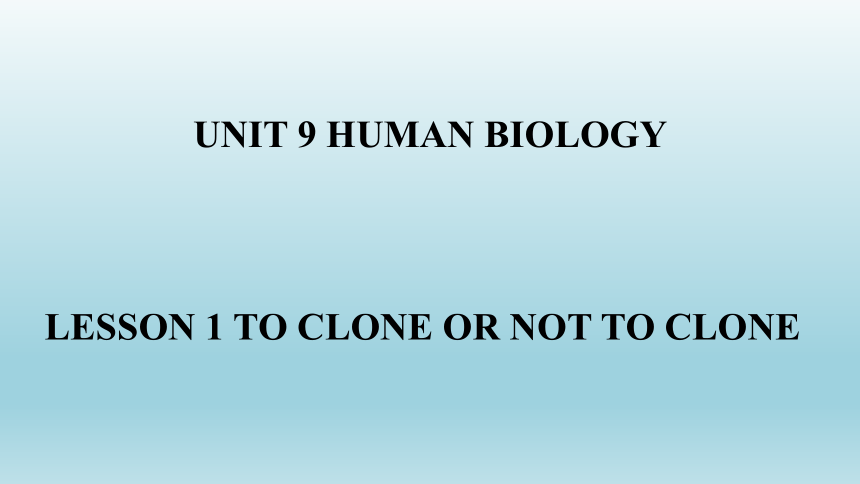 | |
| 格式 | pptx | ||
| 文件大小 | 1.0MB | ||
| 资源类型 | 教案 | ||
| 版本资源 | 北师大版(2019) | ||
| 科目 | 英语 | ||
| 更新时间 | 2023-03-17 20:02:43 | ||
图片预览

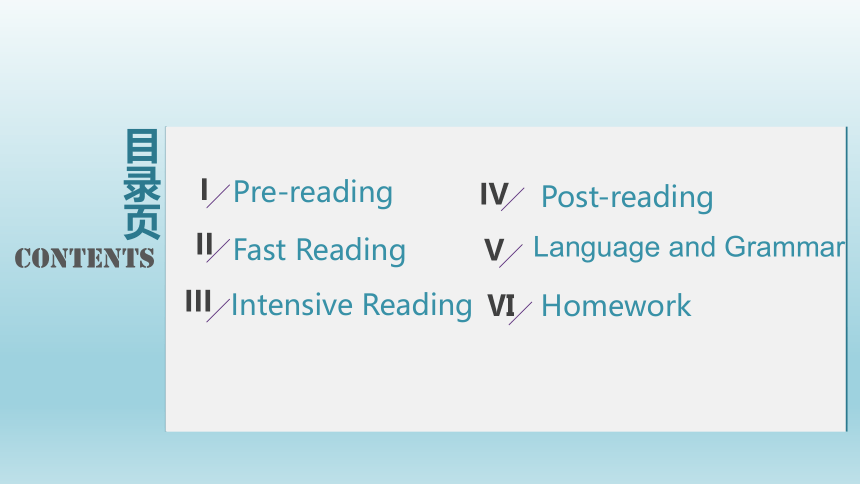

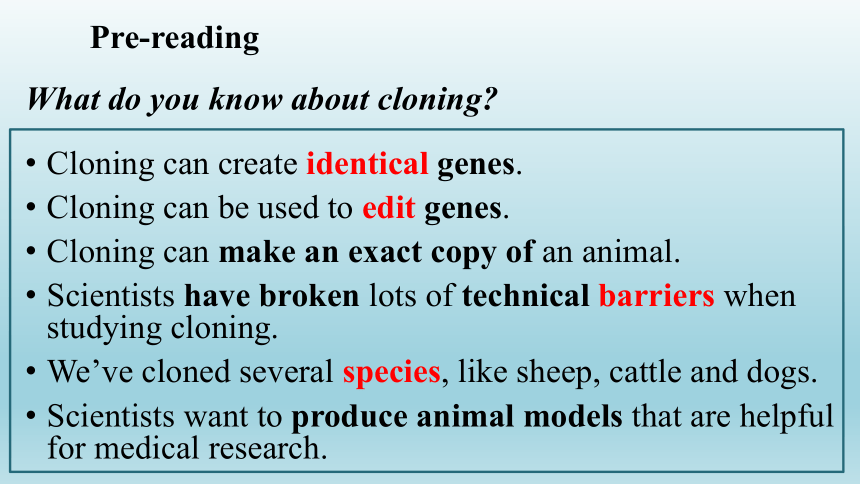
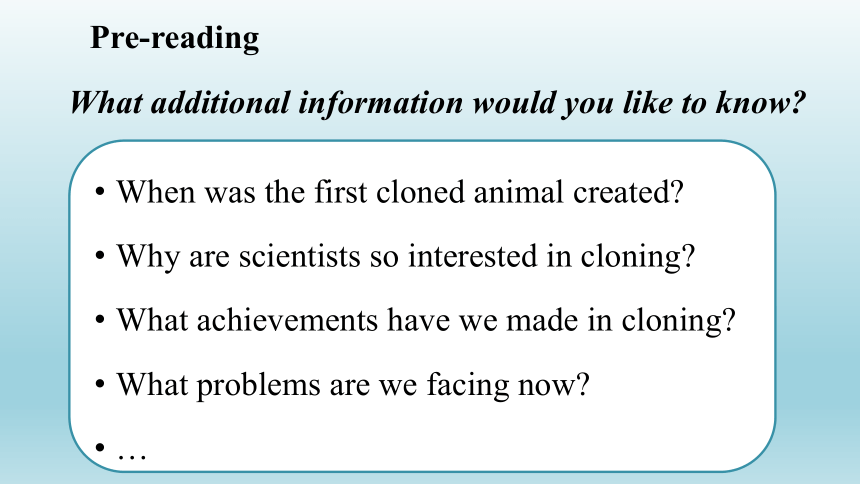




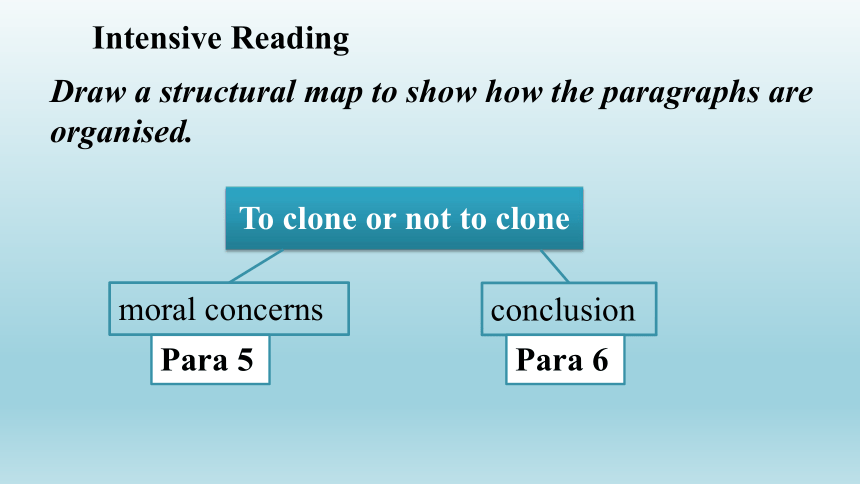
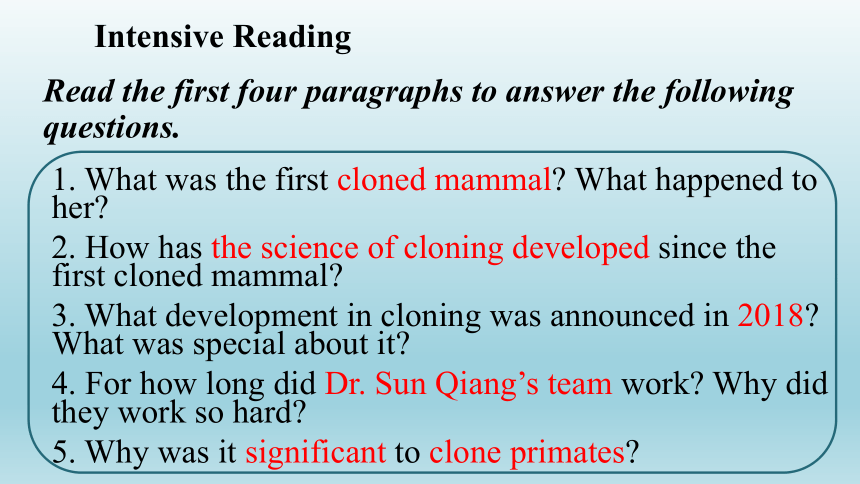
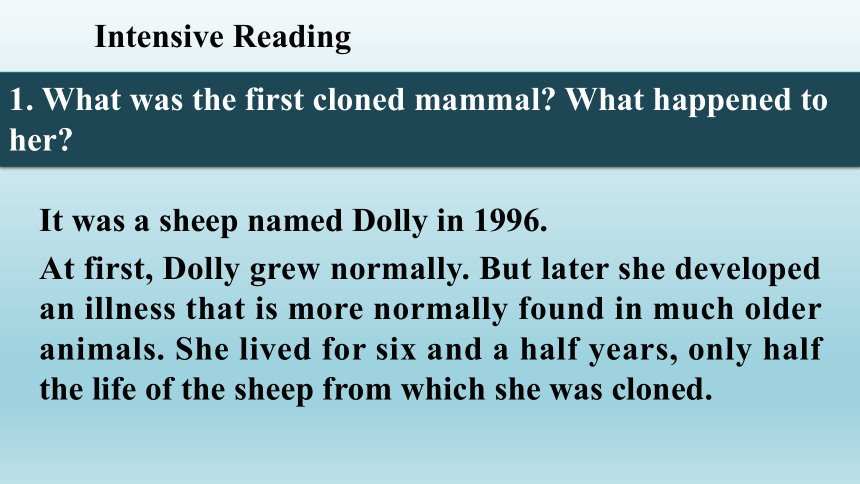
文档简介
(共42张PPT)
UNIT 9 HUMAN BIOLOGY
LESSON 1 TO CLONE OR NOT TO CLONE
目录页
contents
Pre-reading
I
Post-reading
IV
Fast Reading
II
Language and Grammar
V
III
Intensive Reading
Ⅵ
Homework
Ⅰ
Pre-reading
Cloning can create identical genes.
Cloning can be used to edit genes.
Cloning can make an exact copy of an animal.
Scientists have broken lots of technical barriers when studying cloning.
We’ve cloned several species, like sheep, cattle and dogs.
Scientists want to produce animal models that are helpful for medical research.
Pre-reading
What do you know about cloning
What additional information would you like to know
When was the first cloned animal created
Why are scientists so interested in cloning
What achievements have we made in cloning
What problems are we facing now
…
Pre-reading
Ⅱ
Fast Reading
definition & natural cloning
artificial cloning: cloned mammals
artificial cloning: cloned primates
the significance of cloning of primates
moral concerns
conclusion
Fast Reading: Match the headings with the paragraphs
Para 1
Para 2
Para 3
Para 4
Para 5
Para 6
Ⅲ
Intensive Reading
Intensive Reading
To clone or not to clone
definition
natural cloning
Para 1
artificial cloning
Para 2-4
cloned mammals
Para 2
cloned primates
Para 3
the significance of cloning of primates
Para 4
Draw a structural map to show how the paragraphs are organised.
Intensive Reading
To clone or not to clone
moral concerns
Para 5
conclusion
Para 6
Draw a structural map to show how the paragraphs are organised.
Read the first four paragraphs to answer the following questions.
1. What was the first cloned mammal What happened to her
2. How has the science of cloning developed since the first cloned mammal
3. What development in cloning was announced in 2018 What was special about it
4. For how long did Dr. Sun Qiang’s team work Why did they work so hard
5. Why was it significant to clone primates
Intensive Reading
1. What was the first cloned mammal What happened to her
It was a sheep named Dolly in 1996.
At first, Dolly grew normally. But later she developed an illness that is more normally found in much older animals. She lived for six and a half years, only half the life of the sheep from which she was cloned.
Intensive Reading
2. How has the science of cloning developed since the first cloned mammal
After Dolly, scientists have cloned more than 20 mammal species, including camels, cattle, deer, dogs, goats, and mice.
Intensive Reading
3. What development in cloning was announced in 2018 What was special about it
In January 2018, Chinese scientists announced the cloning of two long-tailed monkeys, Zhong Zhong and Hua Hua.
They were the first-ever primates to have been cloned!
Cloning primates is much harder and doing so with non-reproductive cells was even more complicated.
Intensive Reading
Zhong Zhong and Hua Hua
Intensive Reading
4. For how long did Dr. Sun Qiang’s team work Why did they work so hard
They worked 24 hours a day, 7 days a week for more than 5 years.
They wanted to get animals with edited genes and produce animal models that are helpful for medical research and human health.
Intensive Reading
Dr. Sun Qiang and one of his team members
Intensive Reading
5. Why was it significant to clone primates
It might lead to cures for various diseases.
It may offer clues on how to prevent the aging process.
It allows us to have the potential to raise a large number of monkeys with identical genes in a short amount of time.
It may allow us to change their genes to suit research needs.
It could help save research time.
It could reduce the number of animals required for testing.
It could produce more accurate results.
It could lead to more effective treatments.
Intensive Reading
Potential benefits
will lead to cures for various diseases
Intensive Reading
Read paragraphs 5 and 6. Finish the columns.
prevent aging, save research time, reduce the number of animals being tested on, producing more accurate results, better treatments
Moral concerns
has refreshed the technical possibility of cloning of other species
Intensive Reading
clones should be treated as objects or individuals, clones are inferior, some organisations may abuse the technology
Read paragraphs 5 and 6. Finish the columns.
What does Einstein’s quote mean
“Science is a powerful instrument. How it is used, whether it is a blessing or a curse to mankind, depends on mankind and not on the instrument. A knife is useful, but it can also kill.”
Intensive Reading
Science itself cannot be judged as good or bad, because
it can only function when it is used by humans. Humans need to be careful with the information they learn through science and to remember to use science for good.
Ⅳ
Post-reading
Natural cloning has taken place for generations. An example of this is identical 1 _____. A sheep called Dolly was the first mammal to be cloned 2 __________. Since Dolly, more than 20 mammal 3 _______ have been cloned including camels and goats. In 2018, China announced that two monkeys had been cloned. In comparison with other species, scientists have had to work hard to break the technical 4 _______ to get primates with 5 _______ genes.
twins
artificially
species
barriers
edited
Complete the summary using the information in the article.
Post-reading
Scientists say that this major breakthrough offers the 6 ________ to create monkeys with 7 __________ genes to give more 8 ________ research results and perhaps lead to 9 _____ for various diseases. Whilst scientists insist it is 10 ______ to continue research, others raise 11 _____ concerns and worry that the technology might be 12 _______ by some organisations.
potential
identical
accurate
cures
crucial
moral
abused
Post-reading
1. Why do researchers insist that the science of cloning should be further explored and advanced
Post-reading: Think and share
Researchers insist on exploring cloning to continue making progress in curing diseases and developing
treatments.
2. What is the writer’s attitude towards cloning Find evidence.
Post-reading: Think and share
The writer feels that cloning can be a helpful tool in medical research but that it can also become dangerous. Evidence of this is in the writer’s use of Einstein’s quote.
Ⅴ
Language and Grammar
Focus on Language: Difficult sentences
Gardeners have been using a form of cloning when they take a cutting from a plant and place it in a suitable medium, such as soil.
园丁们从植物上截取一段,放在合适的培养基中(例如土壤),就是一种克隆。
Page
52
Focus on Language: Difficult sentences
In comparison with other species, cloning primates has proved to be “much harder”, and doing so with non-productive cells was even complicated.
与其他的物种相比,克隆灵长类动物要“困难得多”,而使用非生殖细胞克隆则更为复杂。
Page
52
Focus on Language: Difficult sentences
The reason they worked so hard to break this technical barrier was to get animals with edited genes and produce animal models that are helpful for medical research and human health.
他们之所以如此努力地要突破这一技术壁垒,是为了获得经过基因编辑的动物,研制动物模型,为医学研究和人类健康发展做贡献。
Page
53
Focus on Language: Difficult sentences
The successful cloning of primates has led to worldwide praise as a huge breakthrough that might lead to cures for various diseases and may also offer clues on how to prevent the aging process.
灵长类动物的成功克隆获得了全世界的赞誉,被认为是一项巨大的突破,从而为治愈多种疾病、延缓衰老提供线索。
Page
53
Focus on Language: Difficult sentences
While some people believe it is crucial for scientific advancement, others raise moral concerns.
尽管有些人认为这对于科学的进步至关重要,但也有人提出了道德方面的担忧。
Page
53
Focus on Language: Difficult sentences
Researchers insist that the science of cloning should be further explored and advanced.
研究人员认为,克隆科学应进一步得到探索与发展。
Page
53
The perfect (完成时):
present perfect 现在完成时
present perfect continuous 现在完成进行时
past perfect 过去完成时
past perfect continuous 过去完成进行时
完成时:结果、完成
完成进行时:动作、持续 / 重复
Focus on Grammar: The perfect
1. Natural cloning has been going on for generations.
2. Gardeners have been using a form of cloning when they take a cutting from a plant …
3. For years, there had been attempts to clone animals.
Identify the tense of the sentences.
Focus on Grammar: The perfect
4. Cloning primates has been proved to be “much harder” than cloning other species.
5. Dr. Sun Qiang said they had been wholly devoted to the research …
6. Dr. Sun Qiang said they had been taking care of more than 1,000 monkeys 24 hours a day, 7 days a week …
Focus on Grammar: The perfect
1. Natural cloning has been going on for generations.
2. Gardeners have been using a form of cloning when they take a cutting from a plant …
3. For years, there had been attempts to clone animals.
present perfect continuous 现在完成进行时
present perfect continuous 现在完成进行时
past perfect 过去完成时
Focus on Grammar: The perfect
4. Cloning primates has been proved to be “much harder” than cloning other species.
5. Dr. Sun Qiang said they had been wholly devoted to the research…
6. Dr. Sun Qiang said they had been taking care of more than 1,000 monkeys 24 hours a day, 7 days a week ...
present perfect 现在完成时
past perfect 过去完成时
past perfect continuous 过去完成进行时
Focus on Grammar: The perfect
Complete the passage with the proper form of the words in brackets.
On Thursday, the Institute of Neuroscience announced it 1 _________ (clone) two monkeys using non-reproductive cells. It is reported that researchers all around the world 2 __________________ (conduct) tests on animals, such as mice and dogs for many years, but couldn’t find a way to clone monkeys.
had cloned
have been conducting
Focus on Grammar: The perfect
Complete the passage with the proper form of the words in brackets.
The news of the successful cloning 3 ___________ (attract) attention from around the world. However, cloning primates 4 ____________ (also raise) ethical concerns. For example, some people 5 _________________ (discuss) issues concerning how clones will be treated in society.
has attracted
has also raised
have been discussing
Focus on Grammar: The perfect
VI
Homework
Search online and find more information about the development of cloning.
Homework
UNIT 9 HUMAN BIOLOGY
LESSON 1 TO CLONE OR NOT TO CLONE
目录页
contents
Pre-reading
I
Post-reading
IV
Fast Reading
II
Language and Grammar
V
III
Intensive Reading
Ⅵ
Homework
Ⅰ
Pre-reading
Cloning can create identical genes.
Cloning can be used to edit genes.
Cloning can make an exact copy of an animal.
Scientists have broken lots of technical barriers when studying cloning.
We’ve cloned several species, like sheep, cattle and dogs.
Scientists want to produce animal models that are helpful for medical research.
Pre-reading
What do you know about cloning
What additional information would you like to know
When was the first cloned animal created
Why are scientists so interested in cloning
What achievements have we made in cloning
What problems are we facing now
…
Pre-reading
Ⅱ
Fast Reading
definition & natural cloning
artificial cloning: cloned mammals
artificial cloning: cloned primates
the significance of cloning of primates
moral concerns
conclusion
Fast Reading: Match the headings with the paragraphs
Para 1
Para 2
Para 3
Para 4
Para 5
Para 6
Ⅲ
Intensive Reading
Intensive Reading
To clone or not to clone
definition
natural cloning
Para 1
artificial cloning
Para 2-4
cloned mammals
Para 2
cloned primates
Para 3
the significance of cloning of primates
Para 4
Draw a structural map to show how the paragraphs are organised.
Intensive Reading
To clone or not to clone
moral concerns
Para 5
conclusion
Para 6
Draw a structural map to show how the paragraphs are organised.
Read the first four paragraphs to answer the following questions.
1. What was the first cloned mammal What happened to her
2. How has the science of cloning developed since the first cloned mammal
3. What development in cloning was announced in 2018 What was special about it
4. For how long did Dr. Sun Qiang’s team work Why did they work so hard
5. Why was it significant to clone primates
Intensive Reading
1. What was the first cloned mammal What happened to her
It was a sheep named Dolly in 1996.
At first, Dolly grew normally. But later she developed an illness that is more normally found in much older animals. She lived for six and a half years, only half the life of the sheep from which she was cloned.
Intensive Reading
2. How has the science of cloning developed since the first cloned mammal
After Dolly, scientists have cloned more than 20 mammal species, including camels, cattle, deer, dogs, goats, and mice.
Intensive Reading
3. What development in cloning was announced in 2018 What was special about it
In January 2018, Chinese scientists announced the cloning of two long-tailed monkeys, Zhong Zhong and Hua Hua.
They were the first-ever primates to have been cloned!
Cloning primates is much harder and doing so with non-reproductive cells was even more complicated.
Intensive Reading
Zhong Zhong and Hua Hua
Intensive Reading
4. For how long did Dr. Sun Qiang’s team work Why did they work so hard
They worked 24 hours a day, 7 days a week for more than 5 years.
They wanted to get animals with edited genes and produce animal models that are helpful for medical research and human health.
Intensive Reading
Dr. Sun Qiang and one of his team members
Intensive Reading
5. Why was it significant to clone primates
It might lead to cures for various diseases.
It may offer clues on how to prevent the aging process.
It allows us to have the potential to raise a large number of monkeys with identical genes in a short amount of time.
It may allow us to change their genes to suit research needs.
It could help save research time.
It could reduce the number of animals required for testing.
It could produce more accurate results.
It could lead to more effective treatments.
Intensive Reading
Potential benefits
will lead to cures for various diseases
Intensive Reading
Read paragraphs 5 and 6. Finish the columns.
prevent aging, save research time, reduce the number of animals being tested on, producing more accurate results, better treatments
Moral concerns
has refreshed the technical possibility of cloning of other species
Intensive Reading
clones should be treated as objects or individuals, clones are inferior, some organisations may abuse the technology
Read paragraphs 5 and 6. Finish the columns.
What does Einstein’s quote mean
“Science is a powerful instrument. How it is used, whether it is a blessing or a curse to mankind, depends on mankind and not on the instrument. A knife is useful, but it can also kill.”
Intensive Reading
Science itself cannot be judged as good or bad, because
it can only function when it is used by humans. Humans need to be careful with the information they learn through science and to remember to use science for good.
Ⅳ
Post-reading
Natural cloning has taken place for generations. An example of this is identical 1 _____. A sheep called Dolly was the first mammal to be cloned 2 __________. Since Dolly, more than 20 mammal 3 _______ have been cloned including camels and goats. In 2018, China announced that two monkeys had been cloned. In comparison with other species, scientists have had to work hard to break the technical 4 _______ to get primates with 5 _______ genes.
twins
artificially
species
barriers
edited
Complete the summary using the information in the article.
Post-reading
Scientists say that this major breakthrough offers the 6 ________ to create monkeys with 7 __________ genes to give more 8 ________ research results and perhaps lead to 9 _____ for various diseases. Whilst scientists insist it is 10 ______ to continue research, others raise 11 _____ concerns and worry that the technology might be 12 _______ by some organisations.
potential
identical
accurate
cures
crucial
moral
abused
Post-reading
1. Why do researchers insist that the science of cloning should be further explored and advanced
Post-reading: Think and share
Researchers insist on exploring cloning to continue making progress in curing diseases and developing
treatments.
2. What is the writer’s attitude towards cloning Find evidence.
Post-reading: Think and share
The writer feels that cloning can be a helpful tool in medical research but that it can also become dangerous. Evidence of this is in the writer’s use of Einstein’s quote.
Ⅴ
Language and Grammar
Focus on Language: Difficult sentences
Gardeners have been using a form of cloning when they take a cutting from a plant and place it in a suitable medium, such as soil.
园丁们从植物上截取一段,放在合适的培养基中(例如土壤),就是一种克隆。
Page
52
Focus on Language: Difficult sentences
In comparison with other species, cloning primates has proved to be “much harder”, and doing so with non-productive cells was even complicated.
与其他的物种相比,克隆灵长类动物要“困难得多”,而使用非生殖细胞克隆则更为复杂。
Page
52
Focus on Language: Difficult sentences
The reason they worked so hard to break this technical barrier was to get animals with edited genes and produce animal models that are helpful for medical research and human health.
他们之所以如此努力地要突破这一技术壁垒,是为了获得经过基因编辑的动物,研制动物模型,为医学研究和人类健康发展做贡献。
Page
53
Focus on Language: Difficult sentences
The successful cloning of primates has led to worldwide praise as a huge breakthrough that might lead to cures for various diseases and may also offer clues on how to prevent the aging process.
灵长类动物的成功克隆获得了全世界的赞誉,被认为是一项巨大的突破,从而为治愈多种疾病、延缓衰老提供线索。
Page
53
Focus on Language: Difficult sentences
While some people believe it is crucial for scientific advancement, others raise moral concerns.
尽管有些人认为这对于科学的进步至关重要,但也有人提出了道德方面的担忧。
Page
53
Focus on Language: Difficult sentences
Researchers insist that the science of cloning should be further explored and advanced.
研究人员认为,克隆科学应进一步得到探索与发展。
Page
53
The perfect (完成时):
present perfect 现在完成时
present perfect continuous 现在完成进行时
past perfect 过去完成时
past perfect continuous 过去完成进行时
完成时:结果、完成
完成进行时:动作、持续 / 重复
Focus on Grammar: The perfect
1. Natural cloning has been going on for generations.
2. Gardeners have been using a form of cloning when they take a cutting from a plant …
3. For years, there had been attempts to clone animals.
Identify the tense of the sentences.
Focus on Grammar: The perfect
4. Cloning primates has been proved to be “much harder” than cloning other species.
5. Dr. Sun Qiang said they had been wholly devoted to the research …
6. Dr. Sun Qiang said they had been taking care of more than 1,000 monkeys 24 hours a day, 7 days a week …
Focus on Grammar: The perfect
1. Natural cloning has been going on for generations.
2. Gardeners have been using a form of cloning when they take a cutting from a plant …
3. For years, there had been attempts to clone animals.
present perfect continuous 现在完成进行时
present perfect continuous 现在完成进行时
past perfect 过去完成时
Focus on Grammar: The perfect
4. Cloning primates has been proved to be “much harder” than cloning other species.
5. Dr. Sun Qiang said they had been wholly devoted to the research…
6. Dr. Sun Qiang said they had been taking care of more than 1,000 monkeys 24 hours a day, 7 days a week ...
present perfect 现在完成时
past perfect 过去完成时
past perfect continuous 过去完成进行时
Focus on Grammar: The perfect
Complete the passage with the proper form of the words in brackets.
On Thursday, the Institute of Neuroscience announced it 1 _________ (clone) two monkeys using non-reproductive cells. It is reported that researchers all around the world 2 __________________ (conduct) tests on animals, such as mice and dogs for many years, but couldn’t find a way to clone monkeys.
had cloned
have been conducting
Focus on Grammar: The perfect
Complete the passage with the proper form of the words in brackets.
The news of the successful cloning 3 ___________ (attract) attention from around the world. However, cloning primates 4 ____________ (also raise) ethical concerns. For example, some people 5 _________________ (discuss) issues concerning how clones will be treated in society.
has attracted
has also raised
have been discussing
Focus on Grammar: The perfect
VI
Homework
Search online and find more information about the development of cloning.
Homework
